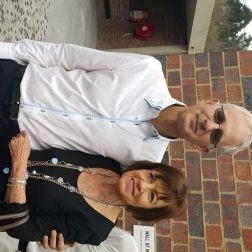News
JHGC – a long-awaited dream has come true
The dedication of the Johannesburg Holocaust and Genocide Centre on Tuesday could not have come at a more appropriate time in South Africa’s history, said Prof Jonathan Jansen, vice-chancellor and rector of the University of the Free State.

MARGOT COHEN
Pictured: Architect and project manager for the Johannesburg centre Lewis Levin, with Pam Lissoos whose late husband, donated his library to the centre.
“Our moral arteries have become hardened by underlying racism of some of our citizens. The awareness and understanding of the Holocaust and Rwandan genocide will bring to attention the abiding dangers of supremacist thinking.”
At a moving ceremony held at the newly-built centre, Jansen made an impassioned plea for all schoolchildren and university students to visit the centre. “All South Africans need this experience,” he said. Jansen is a patron of the SA Holocaust and Genocide Foundation.
The world-class centre of learning is situated on a prime site on Jan Smuts Avenue in Forest Town. It will be the first museum to open in Johannesburg in many years and will broaden the array of cultural experiences now available in the city. It will be open to the public in early 2016.
Director of the JHGC, Tali Nates, said the project started as a dream in 2008. Its founders wanted a resource centre, library, outreach centre for schools and a memory space. They turned to survivors to help find tools of association and translate these into materials which would recall symbols of suffering.
Johannesburg-based architect and project manager for the centre, Lewis Levin, explained the architectural approach. “We spoke to survivors of both Holocaust and Rwandan genocide to assist us. The centre has railway-lines embedded in the walls which recall trees which stood witness to the murders.
“Survivors were haunted by forests and landscapes of death. Rwandan genocide took place amidst lush green vegetation and hills. Tools of association were translated into materials which would recall symbols of suffering.
“Using rows of bricks commonly used in industrial buildings (which often hid atrocities) is a reminder of painful associations. The courtyard stones are made from gravestone off-cuts, recalling pavements of European cities and unmarked graves.
“However, the building is also meant to teach tolerance and compassion and thus includes the art of the brave children of Terezin concentration camp near Prague. The drawings and poems represent their bleak surrounds but rich colours were used and they are full of optimism. The message to South African children is that art can find meaning in suffering and is a call to action.”
The centre will house a memorial to children and a courtyard which promises hope and recovery.
Nates explains that the centre has established itself as a major role-player in the educational field. In the past seven years more than 5 000 learners and hundreds of educators have attended programmes in Gauteng alone.
The national curriculum for grades 9 and 11 which includes Nazi Germany and Holocaust and suggested links to genocide in Rwanda, made the creation of the centre a must.
The centre is committed to assisting the education department, schools and educators, with the implementation of its human rights curriculum. By examining their own environments, schools, home and society – learners are given the opportunity to speak out and not be bystanders in the face of injustice.
The centre will house a permanent exhibition. There will be venues for workshops and public events, a memorial garden and resource centre, a coffee shop and a bookshop.
Together with its sister centres in Cape Town and Durban, the JHGC form the SA Holocaust and Genocide Foundation.
Says Nates: “We will show you history; the rest is up to you.”
Raising awareness of the evils of genocide with particular focus on the Holocaust and the 1994 genocide in Rwanda, it serves as s memorial to the six million Jews who were killed in the Holocaust and more than 80 000 Tutsis and politically moderate Hutus who perished in the 1994 Rwanda genocide.
Pinchas Gutter, a survivor of the Warsaw Ghetto, who takes student groups to Germany and started the Testimony Hologram programme project, Emmanuel Mwezi from Rwanda and Veronica Phillips, a Holocaust survivor, spoke of their experiences and lessons leant.
Another Rwandan survivor, Bonaventure Kageruka, said the building represented a wake-up call. The symbols of a key and rosary belonged to his friend Xavier. Both items were found in the hand of Xavier’s mother, murdered during the genocide.